Opgravingen
plaats: GPS: 50° 55’ 16” N, 3° 7’ 41” O // noordelijke flank van de zilverberg - roeselare, hoogte 39 - 45m
periode van het onderzoek: 26 / 03 / 2002 - 28 / 04 / 2006
C14 datering op de houtskool-bodemstalen door het koninklijk instituut voor het kunstpatrimonium: hoofdzakelijk 2290-2130 vóór Chr. en deels 690-890 na Chr.
research-team van amateurarcheologen gegroepeerd onder V.O.B.o.W. (Vereniging voor Oudheidkundig Bodemonderzoek West-Vlaanderen)en WAR (Werkgroep Archeologie Roeselare) // algemene leiding: jozef goderis
Vondsten
belangrijkste vondst: 28 op meerdere lijnen gerichte paalsporen van een nederzetting, te situeren in de overgang van het einde van de nieuwe steentijd (neolithicum) naar de bronstijd // andere: werktuigen in silex/vuursteen, potscherven uit de gallo-romeinse tijd en de middeleeuwen.
Besluit
nomaden trokken eeuwen lang over de zilverberg als jagers – verzamelaars // zij waren volledig afhankelijk van wat de natuur hen te bieden had
op het einde van de nieuwe steentijd hebben landbouwers en veetelers.zich hier permanent gevestigd
Hedendaagse visualisatie
op de gevonden paalsporen van het bouwsel in hout en stro, staan thans metalen pijlers, niet als een reconstructie, maar als ‘herinnering aan’
een hedendaagse installatie door ‘art in situ team’
Excavations
location: GPS: 50 ° 55 "16" N, 3 ° 7 "41" E // northern flank of the silver mountain - roeselare, height 39 - 45m
period of the investigation: 26/03/2002 - 28/04/2006
C14 dating on the charcoal soil samples by the royal institute for the art heritage: mainly 2290-2130 BC. and partly 690-890 AD.
research team of amateur archaeologists grouped under V.O.B.o.W. (Association for Archaeological Soil Research West Flanders)
and WAR (Workgroup Archeology Roeselare) // general management: jozef goderis
Findings
main find: 28 multi-line pile traces of a settlement, situated in the transition from the end of the New Stone Age (Neolithic) to the Bronze Age // other: tools in flint / flint, potsherds from the Gallo-Roman period and the Middle Ages.
Decision
nomads traveled over the silver mountain for centuries as hunters - gatherers // they depended entirely on what nature had to offer them at the end of the new stone age, farmers and pastoralists settled here permanently
Contemporary vizualisation
metal pillars now stand on the found pile tracks of the structure in wood and straw, not as a reconstruction, but as a "memory of" a contemporary installation by the "art in situ team"
Excavaciones
ubicación: GPS: 50° 55"16" N, 3°7"41" E // flanco norte de la montaña plateada - roeselare, altura 39 - 45m
período de investigación: 26/03/2002 - 28/04/2006
C14 datación en muestras de suelo de carbón vegetal por el instituto real para el patrimonio artístico: principalmente 2290-2130 a. C. y en parte 690-890 d. C.
equipo de investigación de arqueólogos aficionados agrupados bajo V.O.B.o.W. (Asociación para la Investigación Arqueológica de Suelos de Flandes Occidental) y WAR (Workgroup Archaeology Roeselare) // dirección general: jozef goderis
Recomendaciones
hallazgo principal: 28 vestigios de pilotes de varias líneas de un asentamiento, situado en la transición del final de la Nueva Edad de Piedra (Neolítico) a la Edad del Bronce // otros: herramientas de pedernal / pedernal, tiestos de la época galo-romana y la edad Media.
Decisión
Los nómadas viajaron por la montaña de plata durante siglos como cazadores - recolectores // Dependían completamente de lo que la naturaleza tenía para ofrecerles al final de la nueva edad de piedra, los agricultores y pastores se establecieron aquí permanentemente.
visualización contemporánea
pilares de metal ahora se colocan en las pistas de pilotes encontrados de la estructura en madera y paja, no como una reconstrucción, sino como un "recuerdo de" una instalación contemporánea del "equipo de arte in situ"
metalen paaltjes tonen de plaats van vermoedelijk paalsporen van een nederzetting // metal posts show the location of presumably post marks of a settlement
archeosite "oude zilverberg"
more info vobow
panorama zilverberg with the archeosite at the fore




